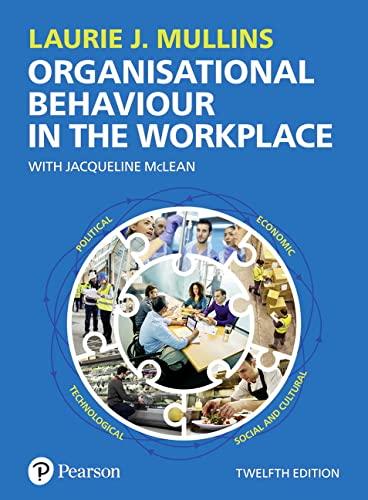In this zone, we critically evaluate the shadow side of organisations and examine whether the covert, informal
Question:
In this zone, we critically evaluate the shadow side of organisations and examine whether the covert, informal aspects of organisational behaviour enable or hinder the completion of day-to-day business activities. An organisation houses a complex menagerie of individuals, each of whom has their own social constructions of reality, their own perceptions of, and commitment to, the workplace and the idiosyncratic roles they play within it. They also have their own set of norms, values, assumptions and, arguably, personal agendas, which may or may not be congruent with, or aligned to, the espoused culture and deeply ingrained way of doing things that have evolved over time.22 According to Linstead et al.,23 these covert, hidden elements of the organisational iceberg metaphor24 are often ignored, suppressed or overlooked by managers and the organisation at large because they are invisible, and therefore undiscussable, unmentionable and elusive.25,26 These elements conflate to form the shadow side of the organisation.22,23,25 The metaphor of the organisation possessing a shadow side was developed by Bowles27 from the work of the eminent Swiss psychologist, Carl Jung. Jung’s original thesis posited that everyone’s personality has a shadow side (one of the four archetypes28), which is a composite of subconscious positive and negative characteristics that are unacknowledged, repressed, buried deep in our psyche and thus hidden from ourselves and others.22 Arguably, recognising that we all have a Jungian shadow side enables us to understand how the metaphor can be applied in an organisational setting. Deeply entrenched social constructions and perceptions of reality, along with covert individual and collective assumptions, norms and values create and perpetuate shadow behaviours (such as the interplay of power and politics and enforcement of personal ideologies and agendas25) that are hidden within the organisation’s metaphorical psyche.27 Stacey29 professes that the shadow coexists with the organisation’s formal/legitimate system in a dynamic, covert, social, political and psychological melee. Both are in a constant state of flux and tension with each other and are maintained through a series of socially constructed negotiations and transactions that enable business activities to be undertaken22 and political deals to be brokered.25 Shadow behaviours are a fact of organisational life. They can be categorised as ‘light’ behaviours, which include corridor conversations, personality clashes and power struggles30 and ‘dark’ behaviours, such as inappropriate absenteeism, suboptimal performance and bullying, which are injurious to both the organisation and individuals and may result in financial consequences.23,31 In studying these behaviours, it may be rather tempting for us to view the shadow as exclusively possessing negative traits that are potentially damaging to the organisation and its members. However, Egan25 and Pheiffer et al.22 concur that the shadow can be a positive force and achieve things that the organisation’s legitimate system cannot. How is this possible? Egan and Nicholls30 suggest that the shadow can enable managers to perform their jobs more proficiently by engaging in ‘accepted’, though unconventional, behaviours (e.g. political game playing and wheeling and dealing) that are not an espoused part of the culture and therefore not sanctioned or endorsed by management. Furthermore, Egan and Nicholls proffer that the shadow initiates and effects change by enabling the status quo to be challenged and in doing so, unearths deeprooted assumptions, values and beliefs that may be restricting the organisation from moving forward.Bowles and Linstead et al. concur that the shadow cannot be managed, due to its unmentionable, undiscussable and invisible nature. Further, Bowles caveats that any attempt to control it would not only be futile but also strengthen its fervour and drive it deeper into the organisation’s metaphorical psyche. Ostensibly, the organisation is a social network, through which shadow behaviours such as gossip, rumours and the grapevine thrive and survive. According to Egan and Nicholls, the network is an informal, unofficial informationsharing medium that enables knowledge and other intel, which may otherwise be bound in red tape, to be disseminated throughout the organisation much faster than through official, legitimate channels. From a managerial perspective, one can appreciate the desire to control shadow social network behaviours, particularly as they can be a doubleedged sword, cutting through the bureaucracy on the one hand and sabotaging and opposing change programmes and strategic goals and objectives on the other. Rather than trying to manage or control the shadow, Nicholls advocates that managers should embrace it as an omnipresent cultural facet and part of established organisational behaviour in the workplace.Similarly, Pheiffer et al. suggest that appreciating the shadow’s presence can help managers understand the nature of, in this instance, politicallymotivated behaviours, and the ways in which they can be leveraged to help the organisation experience growth through change, especially if it is in a state of apathy or decline.32 To conclude, the shadow is an organisational reality that has the capacity to both enable and hinder the completion of daytoday business activities. The shadow side of organisations is unlike any other system, procedure or process that can be measured, deconstructed and reconstructed, but its omnipresence can be felt at every level and in every aspect of organisational behaviour in the workplace. Arguably, the shadow is not wholly light or dark, but has shades of grey. In accommodating the grey areas, McCabe33 advocates that it may provide organisations with a lens through which they can create new states of consciousness and, in turn, identify and utilise alternative ways to behave, organise and govern themselves in the dynamic, global business environment.
1.Critically discuss the most significant features of the organisational shadow. What implications do they have for organisational behaviour in the twentyfirst century workplace?
2.Bowles suggests that any managerial attempts to control the shadow are futile. To what extent do you agree with his view?
3.How can a knowledge and appreciation of our personal shadow help us to understand the complexities and interplay of shadow behaviours in the workplace?
Step by Step Answer:

Organisational Behaviour In The Workplace
ISBN: 9781292245485
12th Edition
Authors: Jacqueline Mclean, Laurie Mullins





